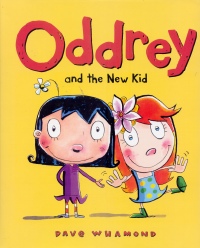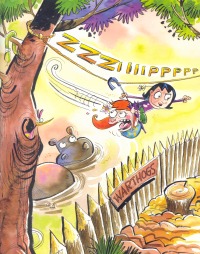| ________________
CM . . .
. Volume XX Number 14. . . .December 6, 2013
excerpt:
Oddrey and the New Kid is the sequal to Oddrey in which the titular heroine Oddrey and her quirky creativity are accepted by her initially disapproving classmates. Oddrey is now popular with both her class and her teacher, and when Maybelline arrives, Oddrey looks forward to making friends with the “fascinating and mysterious” new girl who tells exciting stories of travelling the world and having adventures with her father. But Maybelline is bossy and likes being in the spotlight. Soon Oddrey feels isolated, and she begins to wonder if Maybelline’s stories are all true. On the day of the class trip to the zoo, Oddrey challenges Maybelline, who subsequently climbs into the monkey pit to prove her point. The two have a huge adventure escaping from various animal enclosures and rejoining the class after which Oddrey looks on with a resigned smile as Maybelline relates an embellished account of their experience to their classmates.
I have many questions about the story. Maybelline (perhaps a play on “Make-Believe”) confuses me because she is presented to the reader as an obvious liar and braggart who is helpless when faced with a real adventure (Oddrey has to rescue Maybelline after she jumps into the monkey pit) and neither acknowledges Oddrey’s help nor stops lying afterwards. We are told by the text that she is “good at inventing fun games,” but we actually see her in the illustration for that double spread bossing everybody around; there is no place in the whole story in which Maybelline is shown to have attractive or pleasant qualities. I don’t see much motivation for Oddrey to become friends with such a person, even after the adventure at the zoo, and the fact that “the kids at school just couldn’t get enough of Maybelline’s stories” only makes everyone else seem to be less intelligent than Oddrey. I don’t believe that children’s books need to have any message attached to them; but, if there is one, it should be a positive one. Because the previous Oddrey book had a strong message of accepting people’s quirks, and because the plot of this book indicates something similar, I expected some sort of uplifting moral towards the finale (I wouldn’t have liked it, but I expected it). At the end, Oddrey is seen to smile in a resigned or wry manner towards the reader as Maybelline captivates her audience with her exaggerated story, which perhaps indicates that Oddrey accepts Maybelline for what she is. But do we want people to accept, or even tolerate, liars for what they are? If Oddrey wants to become Maybelline’s friend despite her bossiness and desire for attention, that is laudable, but shouldn’t a real friend stop her friends from lying? The ending is not fair to Maybelline, either, who might have had an opportunity to shine by telling great creative stories, as Oddrey was able to demonstrate that her oddness was not a bad thing at all in the first book, Oddrey. As it is, Maybelline’s capacity for vivid storytelling, which is a wonderful talent in itself, is denigrated as being merely a tendency to lie; and she has no chance to be re-seen as a positive character. We put up with her whereas, if we knew her better, we might even like her. Nitpicky analysis aside, though, Oddrey and the New Kid is a colourful and bouncy picturebook with a colourful and bouncy story (giraffes! warthogs! imaginative utilization of umbrella!), If you don’t think too deeply about the moral (or if you interpret it differently), it is just a story about getting used to sharing the spotlight, making a new friend, and letting someone else be the extra-special snowflake. It is a book that it is highly enjoyable to look through. Recommended with reservations. Sae Yong Kim has an MA in Children’s Literature and is now studying in the MLIS program at the School of Library, Archival and Information Studies, University of British Columbia, BC.
To comment
on this title or this review, send mail to cm@umanitoba.ca.
Copyright © the Manitoba Library Association. Reproduction for personal
use is permitted only if this copyright notice is maintained. Any
other reproduction is prohibited without permission.
NEXT REVIEW |
TABLE OF CONTENTS FOR THIS ISSUE
- December 6, 2013.
AUTHORS |
TITLES |
MEDIA REVIEWS |
PROFILES |
BACK ISSUES |
SEARCH |
CMARCHIVE |
HOME |

 In Oddrey and the New Kid, the energetic illustrations play a larger part than the text; most of the sentences could be taken out without lessening the impact of the story or reader understanding. The illustrations seem to be done in watercolour or coloured ink and fill up the book with vibrancy, a sense of fun, and large actions. Sometimes elements reminiscent of comic strips appear, such as dotted lines to indicate the path of a moving character, dialogue balloons, or sound effects like “Foomp.” Visually, the picturebook is very appealing, even charming.
In Oddrey and the New Kid, the energetic illustrations play a larger part than the text; most of the sentences could be taken out without lessening the impact of the story or reader understanding. The illustrations seem to be done in watercolour or coloured ink and fill up the book with vibrancy, a sense of fun, and large actions. Sometimes elements reminiscent of comic strips appear, such as dotted lines to indicate the path of a moving character, dialogue balloons, or sound effects like “Foomp.” Visually, the picturebook is very appealing, even charming.